
Needle-related Fear versus Vaccination Fear, Vaccination Intention, and Declared Reasons for Avoiding Vaccination
[El miedo a la aguja frente al temor a la vacunaciĂłn, la intenciĂłn de vacunarse y los motivos alegados para evitarlo]
Olga Malas1 and María Dolores Tolsá2
1Medical Emergency System (SEM), Psychology Area, Department of Health, Generalitat of Catalonia, Spain; 2Universitat de Lleida, Spain
https://doi.org/10.5093/clysa2022a11
Received 7 December 2021, Accepted 29 March 2022
Abstract
This study seeks to analyse the relationship between needle-related fear (NF) and vaccination fear (VF), vaccination intention (VI), and the most commonly declared reasons for avoiding vaccination (RAV). The aim was to expand the information on the subject in a pandemic context. Just before starting the vaccination plan. A cross-sectional survey was applied to a sample (N = 2,175) of adult Spanish citizens (37.60 ± 12.98 years), of both sexes (women: 67.3%). Descriptive, correlational, and regression analysis was carried out. For NF, the prevalence was 5.1%, with being a woman, aged between 20 and 40 years old, and without dependents in charge as risk factors. NF presented low but significant relationships with VF, VI, and RAVs (except the one related to vaccine efficacy). This relationship was positive with NF and RAVs and negative with VI. The results are discussed. Actions in NF are recommended to reduce VF and RAVs and increase VI.
Resumen
El objetivo de este estudio es analizar la relación entre el miedo a la aguja (MA) y el miedo a la vacunación (MV), la intención de vacunarse (IV) y los motivos más comúnmente alegados para evitarlo (MEV). Se pretende ampliar la información sobre el tema en un contexto de pandemia. Justo antes de iniciar el plan de vacunación. Se aplicó una encuesta transversal a una muestra (N = 2,175) de ciudadanos españoles adultos (37.60 ± 12.98 años), de ambos sexos (mujeres: 67.3%). Se realizó análisis descriptivo, correlacional y de regresión. Para el MV la prevalencia fue de 5.1%, siendo factores de riesgo ser mujer, entre 20 y 40 años y sin dependientes a cargo. La relación entre MA y MV, IV y MEV (excepto la relacionada con la eficacia de la vacuna) era escasa aunque significativa. Esta relación fue positiva con el MA y los MEV y negativa con el MV. Se comentan los resultados y se recomienda actuar sobre el MA para reducir el MV y los MEV y aumentar la IV.
Palabras clave
Miedo a la aguja, Miedo a la vacunaciĂłn, IntenciĂłn de vacunarse, TeorĂas conspiratorias, VacunasKeywords
Needle-related fear, Vaccination intention, Vaccination fear, Vaccination avoidance, VaccinesCite this article as: Malas, O. & Tolsá, M. D. (2022). Needle-related Fear versus Vaccination Fear, Vaccination Intention, and Declared Reasons for Avoiding Vaccination. ClĂnica y Salud, 33(3), 101 - 107. https://doi.org/10.5093/clysa2022a11
malas.tolsa@outlook.es Correspondence: malas.tolsa@outlook.es (O. Malas).Vaccinations are the best way to promote health by reducing morbidity and mortality from infectious diseases. Nevertheless, the usual administration method, by needle puncture, can cause fear and generate a rejection or avoidance of vaccination. The recorded prevalence of needle-related fear (NF) is highly variable. This is due to the fact that, in general, studies have been carried out in population groups subjected to treatments that require needle administration, as is the case of patients with allergies (e.g., Ferreira et al., 2013, 11%), cancer (e.g., Cox & Fallowfield, 2007, 41%; Harris et al., 2009, 16.9%; Kettwich et al., 2007, 64%), diabetes (e.g., Cemeroglu et al., 2015, 22%; Howe et al., 2011, 9.5-40.9%), dialysis (Mulder et al., 2013, 25.9-26.7%), multiple sclerosis (Turner et al., 2009, 41.4%) or dental interventions (e.g., Armfield, 2010, 13.8%; Elmore et al., 2014, 42.6%; Milgrom et al., 1997, 4.6%; Taani, 2001, 82.1%). As an example, in a sample of young adult travellers attending a vaccination clinic, 21.7% reported that they were afraid of injections and 8.2% described their fear as excessive (Nir et al., 2003). For this excessive or phobic degree of fear, as an example, prevalences of 11 to 19% have been recorded in children (Majstorovic & Veerkamp, 2004), and 3.5 to 10% in the adult population (Nir et al., 2003). Information from the NF in Spanish population is scarce. A significant study was carried out by Prieto (2011), regarding dental puncture in university students, finding a prevalence of 10.7% to 15.1% of moderate level of anxiety and fear; and from 4.1% to 4.7% of high level of anxiety and fear. Studies on avoidance of treatment due to NF have also been carried out in specific population groups such as those undergoing dental interventions (e.g., Crawford et al., 2005, 8%; Vika et al., 2006, 11.3%), diabetes (Zambanini et al., 1999, 13.9%), or dialysis (Mulder et al., 2013, 41.2-55.3%). Regarding avoidance of vaccination, the results showed evidence of avoidance of vaccination against influenza (McLenon and Roger, 2019, 8-27% healthcare personnel, and 6-16% adult patients; Wright et al., 2009, 64.1% adult patients), pneumococci (Johnson et al., 2008, 19% adult population), and tetanus (Johnson et al., 2008, 20% adult population; Wright et al., 2009, 30.8% adult patients). The prevalence of NF, and the avoidance of treatment due to this reason, is influenced by the sociodemographic variables of age and sex. Higher levels of prevalence have been observed in young people and women (e.g., Cox & Fallowfield, 2007; Sokolowski et al., 2010; Wright et al., 2009). In one study carried out in Canada, 63% of children (aged 6-17) reported fear of needles and significant relationships between fear of needles and the female sex, as well as increasing perceived pain intensity during immunizations (Taddio et al., 2012). Everything indicates that NF decreases with age (e.g., Majstorovic & Veerkamp, 2003; Muris et al., 2000). Through meta-regression studies, in studies with samples from Australia, Canada, Egypt, Hungary, India, Italy, Iran, Israel, Saudi Arabia, and Sweden, prevalence data of 20-50% in young people, 20-30% in young adults, and less than 5% in older adults were obtained, observing a decrease of 8.7% per decade (McLenon & Roger, 2019). Concerning sex, Tsao et al. (2006) found that parental anxiety and sensitivity contributed to anxiety and sensitivity in girls but not in boys (aged 8-18). In their turn, McLenon and Roger (2019) recorded a higher mean prevalence in women (1.4 times) than in men, although individual results were heterogeneous, being high in countries such as Saudi Arabia and Israel, but quite low in others like Sweden. In general, the studies refer to children and adolescents. In an Spanish sample, Prieto (2011) did not observe statistically significant differences according to gender. At the time of this study no references were found on the prevalence of NF among adult citizens who needed vaccination as a result of a pandemic such as COVID-19, which affects the world population and has a high rate of infection and mortality, not being comparable to the cases studied referenced in the bibliography. Therefore, given the expected increase in the number of future pandemics and the possibility that NF has a negative impact on vaccination plans, it is considered necessary to address this knowledge gap. In parallel to NF, in previous vaccination plans against influenza, measles, or papilloma, it has been observed that vaccine-related conspiracy theories (CTs) were associated with a greater vaccination refusal (e.g., Jolley & Douglas, 2014; Sallam, 2021). These TCs focus primarily on fear of potential vaccine side effects and in hoaxing and mistrusting in the governments, vaccine manufacturers, and healthcare professionals (e.g., Gualda et al., 2019; Roozenbeek et al., 2020; Sallam et al., 2021). Although negative correlations between vaccination TCs and vaccination intention have been repeatedly established (e.g., Jolley & Douglas, 2014; Roozenbeek et al., 2020; Salali & Uysal, 2020), whether there is any relationship between CTs and NF is unknown, specifically, whether people with NF exhibit more reasons, other than their NF, related to CTs to justify vaccination avoidance. In this context, the present study aims to expand previous research on the relationship between needle-related fear (NF), vaccination fear (VF), vaccination intention (VI), and some commonly used reasons to justify vaccination avoidance in adult Spanish citizens. The hypotheses of the study were that NF (1) will be influenced by demographic variables such as gender and age and will present (2) positive and significative relationships with VF, (3) negative and significative relationship with VI, and also (4) positive and significative relationships with alleged reasons to avoid vaccination (RAV) other than NF. Context The study is carried out in December 2020, in the Autonomous Community of Catalonia (Spain) during the second wave of the COVID-19 pandemic. The date was very close to the implementation of the vaccination plan against the disease, which began at the end of that month. The selected context resembles that used by Mesch and Schwirian (2019) to assess the causes of fear and hesitancy about vaccination, based on the expectation of exposure close to an Ebola outbreak. This context is characterized by recent personal experience of the severity of the disease, eliminating, theoretically, the perceived lack of need, but not their potential concerns about the safety and efficacy of vaccines, the mistrust of government, and the conventional medical system as sources of health information. Participants Two thousand one hundred seventy-five adult Spanish citizens, residents in the Autonomous Community of Catalonia, were recruited for this study. Of this, 32.7% were men and 67.3% women, with a mean age of 37.61 (SD = 12.97). See complete demographic data in Table 1. Table 1 Demographic Characteristics and NF  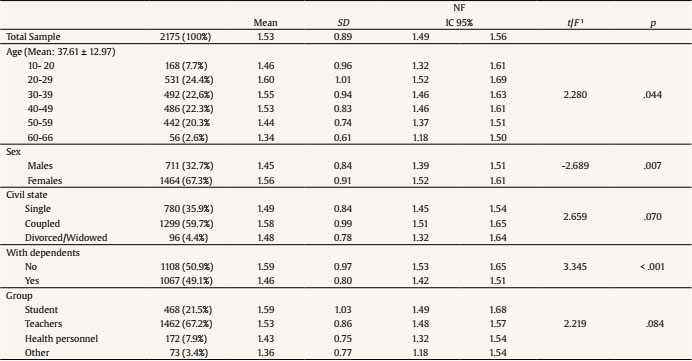 Note.1t statistic for variables with two levels and F statistic for variables with more than two levels. Procedure and Ethics This study was carried out from data obtained from three different databases. The first database includes the results from the recruitment of teachers, the second includes the results of university students and the third database includes the results of emergency medical personnel. Secure Google Forms was used for data collection and storage. The instruments were administered online. Recruitment was carried out with a message containing the study link, which was distributed by email. To obtain the first database, the message was sent to the general mail of all the infant, primary, and secondary education centres in Catalonia, so that they could voluntarily forward it to their teachers. For the second database, the message was sent to approximately 50% of the professors of all the Catalan universities, so that they would voluntarily forward it to their students. For the third database, the message was sent to the person in charge of human resources of the Medical Emergency Service of Catalonia, so that he or she could forward it to his staff. Participation was completely voluntary. Participants were not compensated in any way for their participation. Individuals who clicked the survey link were debriefed on the first page with a description of the study and its aims. Verification that participant data would be recorded anonymously and confidentially was provided, and a statement ensuring that they had the choice to stop participating in the survey at any point in time was also included. Participants digitally provided their informed consent by clicking to proceed to take part in the survey. Thus, to continue administering the questionnaires, each participant had to agree the terms of the study that complied with the Declaration of Helsinki. There were no additional institutional ethical requirements for the authors. Measures Sociodemographic Questionnaire Participants were asked about age, gender, marital state, dependents in charge (with/without minors/older dependents), and employment. Needle-related Fear (NF) Taking into account the experience followed by Hedén et al. (2020), a single item is adapted to ask about the NF (“I do not want to be vaccinated because I am afraid of being pricked with the needle”), which in this case becomes valued using a Likert-type scale with five response options, ranging from 1 (strongly disagree) to 5 (strongly agree), with scores ranging from 1 to 5. Vaccination Fear Scale (VFS-6; Malas & Tolsá, 2021) It is a six-item scale rated on a 5-point scale from 1 (strongly disagree) to 5 (strongly agree) with scores ranging from 6 to 30. Higher scores reflect higher levels of fear. The scale is made up of two subscales of 3 items each, measuring somatic factors and cognitive factors. In order to turn continuous to categorical variables, cut-off points of VFS-6-Cognitive ≥ 9 and VFS-6-Somatic ≥ 4 were indicated. This scale present robust psychometric properties. An exploratory factor analysis (EFA) reveals a satisfactory fit for a bifactorial structure. The Kaiser-Meyer-Olkin value was .86 and Bartlett’s test of sphericity was significant (χ2/df = 252.12, p < .001). Factor loadings were very good for all items (< .60), and the Cronbach’s alpha (α = .88) indicated a satisfactory internal consistency in an adult Spanish sample. In our sample, Kaiser-Meyer-Olkin value was .84 and Bartlett’s test of sphericity was significant (χ2/df = 726.82; p < .001). Factor loadings were adequate to good for all items (485 to 740), and Cronbach’s alpha α = .86. Vaccination Intention (VI) We adapted the single item used by Jolley and Douglas (2017), and Bertin et al. (2020) to assess behavioural intention to be vaccinated against COVID-19. Participants were asked what they would do if they had the opportunity to be vaccinated. They answered on a 5-points scale ranging from 1 (I would definitely not be vaccinated under any circumstances) to 5 (I would be vaccinated without any hesitation). Battery of Reasons for Avoid Vaccination It includes the most common reasons for avoid vaccination (RAV) in western societies. Several steps were taken to develop the battery of reasons for avoiding vaccination. First, a literature review was conducted to assess all reasons recorded by other researchers (e.g., Gualda et al., 2019; Larson et al., 2018; Shapiro et al., 2016). All the sentences found were listed and subsequently analysed by two researchers independently, eliminating expressions with similar content and classifying the rest as relevant or not relevant in the Spanish context. A single list was then made by consensus. The initial list was made up of 9 items. A group of 24 people (16 students and 8 health professionals) were asked to rate their level of belief in each one, on a 5-point Likert scale. None of them scored on 4 of the items. So, after carefully analysing them, they were eliminated. Additionally, an individual interview was implemented on the same pilot participants to explore their thoughts about each scale item and their responses. As result, no further changes were made. Finally, five sentences made up the battery:
The sentences were evaluated, using a Likert-type scale with five response options, ranging from 1 (strongly disagree) to 5 (strongly agree), with scores ranging from 5 to 25. Statistical Analysis Demographic characteristics were studied using frequency analysis. To identify if there were significant differences in NF related to sociodemographic variables the Student’s t-test (variables with two levels) or ANOVA test (more than two levels) was carried out. The NF, VF, VI, and RAVs variables were studied via frequency analysis and descriptive calculation. Additionally, we calculated skewness and kurtosis values and Kolmogorov-Smirnov normality test (n > 50) to check the normal distribution of data. None of the variables fulfilled the assumption of normality (p < .05), so non-parametric inferential tests were applied. To investigate the relationship between variables, a correlation analysis was applied. Spearman’s rho coefficients were determined. Also, gamma (Γ) and Somers’ D statistics as indicative of the strength and directionality of the association were used. Next, multiple linear regression analyses (‘enter’ method) were conducted to examine the strength of the associations between NF and NF plus sociodemographic covariables of gender, age, and dependents in charge (independent variables) versus the VF, VI, and RAVs (dependent variables). Separate regressions—one each for variable—were conducted. Statistical analyses were performed using the SPSS v.27 package. Demographic Characteristics Demographic prevalences can see in Table 1. Significant differences were observed in NF related to age (F = 2.280, p = .044), gender (t = - 2.689, p = .007), and whether or not they had dependents in charge (t = 3.345, p < .001), with being a woman, from 20 to 40 years (maximum around 29 years according to graphical representation of NF means against age), and without dependents as risk factors. According to study data, 5.2% of the sample agree and strongly agree with the sentence related to NF and 40% would have VF (see Table 2). In parallel, only 49.8% agree or strongly agree with the statement regarding VI. RAVs could be behind these percentages of VF and VI, particularly beliefs about the utility and safety of vaccines. Table 2 Prevalences for NR, VF, VI, and RAVs (N = 2,175)  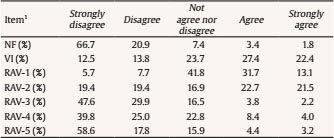 Note. 1NF = needle-related fear; VI = vaccination avoidance; RAV = reasons to avoid vaccination (described in the Method section). Descriptive Statistics and Correlations The mean, skewness, and kurtosis can be seen in Table 3. The results for skewness and kurtosis were greater than 2 for NF, indicating non-parametric data. Other variables were within the range of ± 1.5 indicating that the distribution curve is symmetric or relatively symmetric. The Kolmogorov-Smirnov test indicates that all the variables follow a non-parametric distribution (p < .05). Consequently, non-parametric statistics were applied next. Table 3 Descriptive Statistics for NR, VF, VI, and RAVs (N = 2.175)  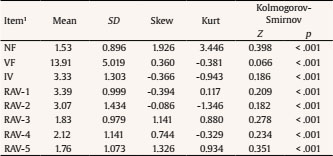 Note. 1NF = needle-related fear; VF = vaccination fear; VI = vaccination intention; RAV = reasons to avoid vaccination. The results of the correlations between the analysed variables, as well as the strength and directionality of the associations, can be seen in Table 4. Evans (1996) classified the correlation levels at .00-.19 as very weak, .20-.39 weak, .40-.59 moderate, .60-.79 strong, and .80-1.0 very strong. Hence, NF showed a weak and positive correlation with VF, also with RAV-2 (beliefs on vaccines safety) and with RAV-3 to RAV-5 (beliefs about hoax and distrust). Consequently, NF presented a weak and negative correlation with VI. In the same way, Somers’ D value, although also low, confirms that the effect of NF on VI is negative and on VF and RAV-2 to RAV-5 positive. For RAV-3 to RAV-5 (hoax and distrust beliefs), the gamma values (.35-.54) indicate an adequate to good probability of effect. Table 4 Correlations, Strength, and Directionality for NF vs. VI, VF, and RAVs  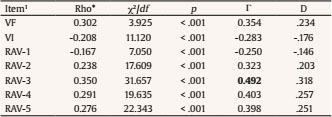 Note. 1NF = needle-related fear; VF = vaccination fear; VI = vaccination intention; RAV = reasons to avoid vaccination. *All correlations were significant at the .01 level (two-tailed). Hierarchical Regression Analysis NF is significantly associated (t > 3.0, p < .01) with all the variables analysed (see Table 5), presenting an explained variance of 8.4% for VF, 3.7% for VI, and from 2.2 to 8.2% for RAVs. Covariates increase the explained variance to 14.2% for VF, 6.2% for VI, and 5.1 to 12.4% for RAVs. Gender is the covariate with the highest incremental explained variance in all variables, except for RAV-3 (hoax belief) not affected by any of the covariates analysed. Age is the least significant, increasing the explained variance only in VI and in RAV-1 and RAV-2 (beliefs about utility and safety), but not for VF or other RAVs. In the same way, having dependents in charge increases the explained variance of all the variables, except RAV-3 to RAV-5 (hoax and distrust beliefs). The sample analysed is large and has allowed the aims of this study to be achieved. In the first place, they allow us to establish prevalences of 5.1% for NF, 40% for VF, and 49.8% for VI. In turn, percentages of 44.8% were obtained for negative beliefs related to the usefulness of vaccines, 44.2% related to their safety, 6% who do not believe in the information on the severity of the disease, 12, 4% who see the interests of pharmaceutical companies behind, and 7.6% who distrust the information provided by the government. In any case, the percentage of people who declare neither for nor against is striking, being indicative of the high percentage of hesitant, especially for VI (23.7%) and for those who doubt the efficacy of the vaccine for controlling the infection (41.8%). The prevalence of 5.1% obtained for NF is within the range of 3.5 to 10% reported by Nir et al. (2003) for the adult population, but it is lower than the 8% reported by Crawford et al. (2005), and 11.3% by Vika et al. (2006). It is also below the 10.7% to 15.1% reported by Prieto (2011) in the Spanish adult population. In any case, these differences may disappear if we take into account that 7.4% declared themselves undecided (perhaps fearful). Table 5 Hierarchical Regression Analysis for NF and NF plus Sociodemographic Covariates versus VF, VI, and RAVs  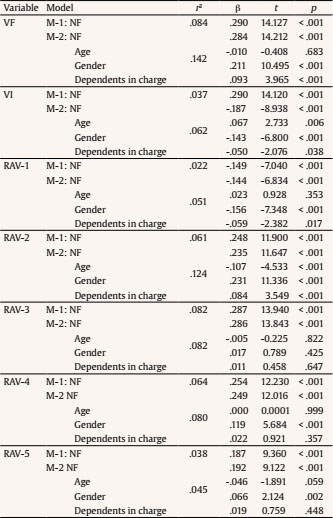 Note. NF = needle-related fear; VF = vaccination fear; VI = vaccination intention; RAV = reason to avoid vaccination; M = model. The analysis of NF related to sociodemographic variables indicates being a woman (t = -2.68, p < .007), of 20 to 40 years (F = 2.28, p = .044), and without dependents in charge (t = 3.345, p > .001) as risk factors. Being female has previously been described as a risk factor by other researchers (e.g., Cox & Fallowfield, 2007; Sokolowski et al., 2010; Tsao et al., 2006; Wright et al., 2009). But not by Prieto (2011) in a sample of Spanish university students. This divergence was also detected by McLenon and Roger (2019) in their meta-analysis of samples (mostly children and adolescents) from Australia, Canada, Egypt, Hungary, India, Italy, Iran, Israel, Saudi Arabia, and Sweden, observing a higher average prevalence in women compared to men, but with high data in countries such as Saudi Arabia and Israel, and quite low in others such as Sweden. The differences described by these researchers could be related to the specific group analysed. For age, in the present study, the prevalence of NF increases during the third decade of life, after which it begins to decline. Therefore, initially, it could be said that the data obtained in this study differ from those reported by other researchers such as Majstorovic and Veerkamp (2003) or Muris et al. (2000), who indicate that NF decreases with age in the adult population. Also McLenon and Roger (2019), who established a decline of 8.7% per decade. But if we take into account the studies carried out in children and adolescents, we observe that NF is higher in the group of adolescents (e.g., Cox & Fallowfield, 2007; Sokolowski et al., 2010; Wright et al., 2009). So, in a first phase, NF increases with age, confirming obtained results. The correlation analysis results were in line with hypotheses 2 to 4. NF has weak but significant and positive correlations with VF (rho = .30, p > .001, Γ = .35, D = .23); and weak but significant and negative with VI (rho = -.20, p > .001, Γ = -.28; D = -.17). With respect to RAVs, correlations were significant (p < .001, Γ = .32 to .49, D = .20 to 0.32) and positive but weak (rho = .23 to .35) for all, except for RAV-1 (negative belief in the efficacy of the vaccine for infection control) which present a very poor correlation. The strongest correlations were with RAV-3 (hoax belief about the severity of the infection) and with RAV-4 (mistrust of pharmaceutical companies), followed by RAV-5 (mistrust in government). Contrary to what might be expected, RAV-2 (negative belief in the safety of vaccines and their side effects) shows a lower correlation than RAV-3, RAV-4, or RAV-5, which seems to indicate that NF and its possible causes, such as injection pain, have not been linked to the safety of the vaccine, a fact that is consistent with the etiology of NF. The hierarchical regression analysis confirms the data found in the correlation analysis. The explained variance of NF on VF and VI is significant (β = .29, t > 14.0, p < .001) but relatively low (8.4% and 3.7% respectively), and highly influenced by sociodemographic variables of gender and dependency, capable of increasing it up to 14.2% and 6.2% respectively. In the same way, the explained variance of NF in RAV2 to RAV-5 is also significant (β = .18 to .28, t > 9.3, p < .001) but relatively low (6.1%, 8.2%, 6.4%, and 3.8% respectively), increasing as consequence of the sociodemographic variable of gender, and less by dependency, at 12.4%, 8.2%, 8.0%, and 4.5% respectively. RAV-1 on the efficacy of the vaccines presented a lower explained variance (2.2%, increased by sociodemographic variables to 5.1%) and a negative relationship. In conclusion, the results confirm the study hypotheses. NF is influenced by sociodemographic variables of age, gender, and dependency. NF presents significant (although low) relationships with analysed variables, being positive with FV, negative with VI, and positive with RAVs related to negative beliefs about the safety of vaccines, hoax about the severity of the infection, and mistrust of pharmaceutical companies and the government. Only RAV on vaccine effectivity not was confirmed. Limitations The results may be influenced by several limitations present in the study. First, the sample includes a high proportion of women, and teachers or students, not being representative of the general Spanish population. Second, the ethic approval did not enable the gathering of participants information before inviting them to enrol in the study. Thus, it is likely that the final sample examined in the study may not be representative of the analysed groups. So, it may be questionable how the results may apply to general population. In future studies, it would be advisable to test other population groups, which will allow a more precise estimate of the prevalence of needle-related fear and their relation with vaccination intention or reasons for avoiding vaccination. Third, the cross-sectional design of the study does not allow conclusions to be drawn on cause-effect. Long-term studies are recommended to delve into this topic. Finally, the current study relied exclusively on self-report. The nature of self-report measures has not allowed us to objectively evaluate the associations between the study variables, which could in turn be affected by factors of social desirability or other sources of bias, such as ease of access or use of on-line tools. All in all, the results open up the possibility of continuing the investigation on this matter. Clinical Implications This study analyses the relationship between NF and RAV, related to negative beliefs about the efficacy and safety of vaccines, and certain conspiracy theories of hoax and mistrust. The results indicate that people affected by NF were more likely to express RAVs related to hoax and mistrust. In general, these beliefs are characterized by being nebulous, resistant to refutation (Lewandowsky et al., 2013) and very stable over time (Jolley & Duglas, 2014). In view of the results obtained in this study, NF could explain the difficulty of reversing this type of belief in a part of the population. On the other hand, in this sample the percentage that answers neither for nor against when asked about NF (7.4%) or VI (23.7%) stands out. This percentage of hesitant constitutes an optimal working group to reduce the levels of NF and VI, since, as indicated by Salmon et al. (2015), it is a population group that tends to opt for one or another direction depending on the context, time, place, complacency, convenience, and trust. Finally, although the data confirm that NF decreases with age, the maximum prevalences are around 20 and 40 years of age, so interventions to reduce NF in the adult population will be appropriate as a measure to reduce the vaccination avoidance. Conflict of Interest The authors of this article declare no conflict of interest. Cite this article as: Malas, O. & Tolsá, M. D. (2022). Needle-related fear versus vaccination fear, vaccination intention, and declared reasons for avoiding vaccination. Clínica y Salud, 33(3), 101-107. https://doi.org/10.5093/clysa2022a11 References |
Cite this article as: Malas, O. & Tolsá, M. D. (2022). Needle-related Fear versus Vaccination Fear, Vaccination Intention, and Declared Reasons for Avoiding Vaccination. ClĂnica y Salud, 33(3), 101 - 107. https://doi.org/10.5093/clysa2022a11
malas.tolsa@outlook.es Correspondence: malas.tolsa@outlook.es (O. Malas).Copyright © 2025. Colegio Oficial de la Psicología de Madrid








 e-PUB
e-PUB CrossRef
CrossRef JATS
JATS







